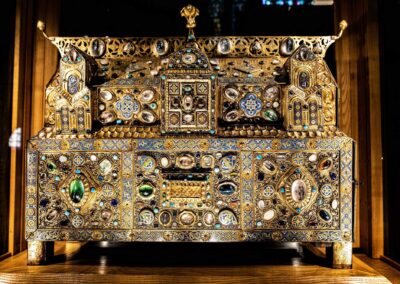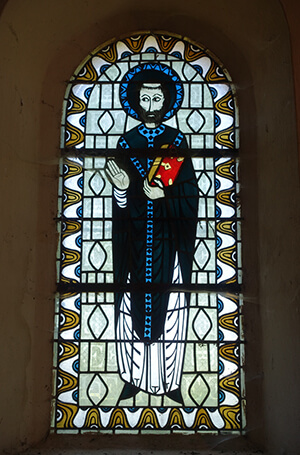explore the Monts du Limousin
The Order of Grandmont and its treasures
Located 28 kilometres from Limoges, on the Saint-Sylvestre commune, the Grandmont village is nested in the heart of the Monts d’Ambazac, at the foot of Puy de Sauvagnac, which rises to 702 metres. Classic little Limousin village that has kept the nature of its old houses and beautiful granite stones, which only reveal its historical interest to the most curious visitors. During 7 centuries, Grandmont was the centre of a prestigious religious order and of a shining Abbey, now dismantled.
The Story of Grandmont Abbey
The creation
Around 1076, the founder of the Order of Gramont, Étienne, probably from a noble family in Auvergne, retires to Grand Muret in the commune of Ambazac, to live a life completely devoted to God as a hermit. Over time, he formed a community around him, which was to become the core of the Order of Grandmont.
Shortly after his death in 1124, his disciples decided to settle in Grandmont on a wild plateau, a dozen kilometres from Grand Muret. Brothers are sent to set up the site and the new buildings. In June 1125, the community left Grand Muret for Grandmont.
The expansion
Grandmont’s renown grew throughout the 12th century with, among others, the development of a pilgrimage around the relics of the Étienne and the construction of a new church. The Order of Grandmont will rapidly spread: more than a hundred houses will be created in less than a century.
The Plantagenet legacy
A great prince: Henri II Plantagenet, who will become king of England in 1154, will leave a lasting mark on the place. He was the monastery’s benefactor. He wished to be buried there and financed major work.
The place is completely redeveloped: a new monastery complex sees the day and in 1166, the new church was consecrated. With the presence of the Plantagenet, the monastery became a political centre.
Tensions and changes
Grandmont will benefit from the protection and generosity of kings and princes, which will contribute to the enrichment of the treasure. However, from the end of the 12th century, internal disputes between the clerics and the converses (laypeople) disrupted the smooth running of the community.
In 1317, following the crisis, Pope Jean XXII transformed the monastery into a Benedictine Abbey. In the second half of the 14th century and of the 15th century, the abbey underwent several series of occupations that resulted in major destructions of the buildings. First and foremost, it was occupied by French troops, then English troops, during the Hundred Year’s War and successively by Catholics and protestants, during the wars of religion.
Abolishment of the Order
Despite the repairs of the buildings in the first half of the 17th century, a century later, the state of the abbey is considered worrying. Between 1732 and 1768, a new church and convent buildings were built. It was a large-scale reconstruction at a time when finances were poor and the religious community had been reduced to a dozen of members.
In 1772, the order was cancelled, but the abbot, with a few clergymen, lived in the abbey until their death. In 1789, the services of the bishopric of Limoges took charge of liquidating all assets.
The inhabitants of Grandmont were allowed to collect the stones needed to build a small chapel. This chapel is dedicated to Saint Jean-Baptiste, leader of the hermits. She was inaugurated on June 15, 1825, in the presence of the last surviving Grandmontain : Dom Pierre Vergnaud (1747-1827).
And its treasures…
Church Saint Antoine – Ambazac
Reliquary shrine
This chest, in which were kept the relics of Saint Macaire and of Saint Étienne de Muret was carried out in the 12th century. The hunt was in all likelihood offered by the king of England and the Duc of Aquitaine, Henry II Plantagenet in the Grandmont abbey. It is one of the largest copper and champlevé enamel caskets from this period preserved in France.
Dalmatic
It refers to the clothes worn by deacons. According to the legend, it was given to Étienne de Muret by Mathilde, wife of the Emperor of the Holy Roman Empire and granddaughter of Guillaume the Conqueror, for the birth of Goeffrey Plantagenet around 1134. However, historians attribute Hispanic and Moorish origins to the late 13th century.
Church of the Nativity of Saint-Jean-Baptiste –
The Billanges
The reliquary arm of Saint Félicien
Dating back to the 13th century, it is made of wood and covered with embossed silver plats. Three bands of gilded filigree are embellished with semi-precious stones. The observe features a hinged door, while the interior contains relics wrapped in red cloth.
Church saint Sylvestre – Saint-Sylvestre
Reliquary bust
This goldsmith’s piece is made of silver, and represents the holy founder of the Order of Grandmont. The bust dressed in the costume of a deacon was offered in 1496 by the cardinal Guillaume Briçonnet to the abbey of Grandmont where he was the 11th abbot. The silver head could be attributed to a Tuscan workshop (Italy).
Reliquary of Saint Amand and of saint Junien
According to the inscription, it was ordered by Pierre de Montvalier, canon of Saint-Junien, who offered it to the abbey of Grandmont in 1225. The reliquary was crowned by a figure in the round of Saint Junien, which was already missing in 1790.
The SASSAG
The association called « Société des Amis de Saint-Sylvestre et de l’Abbaye de Grandmont » ( Society of Friends of Saint-Sylvestre and of the Abbey of Grandmont) was founded in 1934.
Its goals are to look after the architectural, archaeological, and artistic treasures of Saint-Sylvestre, to raise awareness of the story of the Grandmont Abbey and the Order of the same name, to search for relics, carry out excavations, to collect and protect all documents, testimony, in order to safeguard them and enhancing them
Visits are organised all year round on request. Since 2013, on the initiative of the SASSAG and under the aegis of professor Ph. Racinet of the University of Picardie Jules Verne, an excavation site is scheduled every summer during the month of July and visits are organised around this period.





















